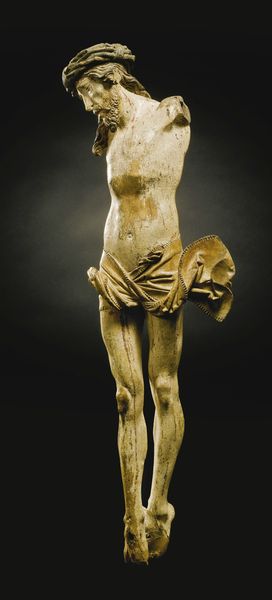Attributed to Tilman Riemenschneider (C. 1460-1531), German, Würzburg, circa 1490-1500, Corpus Christi.
Attributed to Tilman Riemenschneider (C. 1460-1531), German, Würzburg, circa 1490-1500, Corpus Christi. Photo courtesy Sotheby's
polychromed limewood; 61.5cm., 24¼in. Estimate 200,000-300,000 GBP
PROVENANCE: private collection, Würzburg;
art market, Munich
EXHIBITED: Würzburg, Mainfränkisches Museum, Tilman Riemenschneider - Frühe Werke, 1981, no. 48;
Paris, Musée du Louvre, Sculptures allemandes de la fin du Moyen Age dans les collections publiques francaises. 1400-1530, 1991-1992, no. 49
LITTERATURE: B. Buczynski, F. Buchenrieder, P.Bloch et al., Tilman Riemenschneider - Frühe Werke, exh. cat. Mainfränkisches Museum, Würzburg, Berlin, 1981, p. 236, no. 48;
Sculptures allemandes de la fin du Moyen Age dans les collections publiques francaises. 1400-1530, exh. cat. Musée du Louvre, Paris, 1991, pp. 186-187, no. 49
NOTE: In the seminal 1981 exhibition on Tilman Riemenschneider’s early work the present corpus was published as one of a group of small corpora produced by the young master. The figure’s distinguished naturalism and the exquisite rendering of the face and drapery show Riemenschneider’s talent for small scale sculpture for private devotion – a lesser known facet of his oeuvre.
The corpus is likely to have formed part of an ensemble like that kept in the Hessisches Landesmuseum in Darmstadt (inv. no. PL.01.08), which shows Christ on the cross flanked by Mary and St. John the Evangelist on a rocky base meant to resemble Golgotha. These miniature altarpieces were the centre of private chapels and cells of noblemen and clerics and, as such, they formed the focus of their solitary prayers and confessions. The empathy with which Riemenschneider represented the crucified Christ must have been successful. Three further fragmentary corpora survive in the Mainfränkisches Museum in Würzburg (inv. nos. S43503 and 4) and in the Convent of the Misericordia Sisters in Graz. Each of these figures is characterised by a fine sense of plasticity and mastery of unstrained anatomy typical of Riemenschneider. The drapery invariably crosses at the front of the body and, when well-preserved, terminates in flourishes such as that on the proper left side of the present figure. A particularly similar execution of this side of the perezonium can be seen on a larger scale in Riemenschneider’sCrucifix with St. Nicholas and St. Catherine in Steinach an der Saale. The long straight nose, angled open eyes, strand of hair flowing onto the shoulder and the dense crown of thorns are equally comparable. The contrast between the high finish of the drapery and less sinewy treatment of the anatomy in the present corpus, however, led Muth to suggest that this is the first of the surviving corpora (op.cit., 1981, no. 51).
Tilman Riemenschneider was born in Heiligenstadt in 1460. Little is known of the sculptor's early career, although it is likely he was apprenticed to a stone mason in Erfurt, specialising in carving alabaster. He settled in Ulm for a time, where he may have worked as an apprentice to Michel Erhart. A "Tilman Riemenschneider" appears in the Würzburg town records before 1479 when he turned down a commission for an altarpiece. Settling and marrying there in 1483, he became a citizen and a member of the painter's Guild of Saint Luke, achieving the status of 'Meister'. His new wife's wealth provided a large house with sufficient space for workshops and quarters for assistants, apprentices and his family. He subsequently received numerous commissions from various town councils, including one in 1490 from the town council of Münnerstadt for an altarpiece for the high altar of St. Maria Magdalene, the parish church. Further major commissions were executed by Riemenschneider's workshop for local patrons, as well as for clients in Franconia and Saxony. In 1504, he was elected to Würzburg city council and, in 1509, he was the first artist to enter the Upper Council. He was elected mayor of the town in 1520-21, by which time he had married for the fourth time. During the peasant revolt in 1525, Riemenschneider allied himself with the lower classes against the Prince-Bishop, Conrad von Thüngen. As a result of his actions, he was arrested, imprisoned and tortured. Riemenschneider's steadfast empathy during the revolt is manifest in the soulfulness of his sculpture.
After his death in 1531, interest in Riemenschneider's work waned considerably due to changing tastes as well as the Reformation. Most of his sculpture was destroyed or modified, which is why works of art attributed to him and his atelier are extremely rare. Since the 19th century, however, appreciation of Riemenschneider's work has been rejuvenated. With the 1931 Hannover exhibition on the occasion of the 400th anniversary of his death, which followed the publication of the first volume of Justus Bier's monograph, interest in Riemenschneider's brilliance continued its revival. At this time, his popularity in Germany was only surpassed by Albrecht Dürer's (Chapuis, op.cit. p.20). The renewed interested in German art and the early 20th-century dispersal of prestigious private collections containing important works by Riemenschneider, spurred museums such as Berlin and Munich to purchase his works. Wixom (Chapuis, op.cit., p. 149) explains that the great European collections influenced the tastes of foreign collectors and museums, particularly in America, who consequently sought out German masterpieces.
RELATED LITERATURE: Riemenschneider Gedächtnis-Ausstellung 1931, exh. cat. Museums für Kunst und Landesgeschichte im Provinzial-Museum, Hanover, 1931; M. Baxandall, The limewood sculptors of Renaissance Germany, New Haven/ London, 1980, pp. 172-90, 259-65; H. Muth (ed.), Tilman Riemenschneider – Frühe Werke, exh cat. Mainfränkisches Museum, Würzburg, 1981, nos. 8, 49-51; H. Muth, Tilman Riemenschneider. Die Bildwerke des Bildschnitzers und Bildhauers, seines Werkstatt und seines Umkreises in Mainfränkisches Museum, cat. Mainfrankisches Museum, Würzburg, 1982, pp. 140-141 and 162-165, nos. 32 and 38; J. Chapuis,Tilman Riemenschneider. Master sculptor of the late Middle Ages, London, 1999
Sotheby's. European Sculpture & Works of Art: Medieval to Modern. London | 02 juil. 2013 www.sothebys.com

/https%3A%2F%2Fprofilepics.canalblog.com%2Fprofilepics%2F1%2F0%2F100183.jpg)
/https%3A%2F%2Fstorage.canalblog.com%2F03%2F02%2F119589%2F96711876_o.jpg)
/https%3A%2F%2Fstorage.canalblog.com%2F11%2F31%2F119589%2F94773502_o.jpg)
/https%3A%2F%2Fstorage.canalblog.com%2F20%2F83%2F119589%2F94772815_o.jpg)
/https%3A%2F%2Fstorage.canalblog.com%2F26%2F72%2F119589%2F75604929_o.jpg)
/https%3A%2F%2Fstorage.canalblog.com%2F59%2F60%2F119589%2F26458628_o.jpg)








/http%3A%2F%2Fstorage.canalblog.com%2F78%2F52%2F119589%2F71451009_o.jpg)
/http%3A%2F%2Fstorage.canalblog.com%2F97%2F08%2F577050%2F40435064_p.jpg)
/http%3A%2F%2Fstorage.canalblog.com%2F61%2F46%2F119589%2F33613434_o.jpg)
/http%3A%2F%2Fstorage.canalblog.com%2F90%2F14%2F119589%2F33612741_o.jpg)